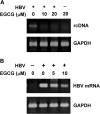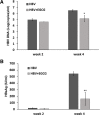Epigallocatechin gallate inhibits hepatitis B virus infection in human liver chimeric mice
- PMID: 30189898
- PMCID: PMC6127945
- DOI: 10.1186/s12906-018-2316-4
Epigallocatechin gallate inhibits hepatitis B virus infection in human liver chimeric mice
Abstract
Background: Persistent hepatitis B virus (HBV) infection causes liver cirrhosis and hepatocellular carcinoma and constitutes a major worldwide health problem. Currently, anti-HBV drugs are limited to peginterferon and nucleos(t)ide analogs, which are costly and have considerable side effects; the development of novel, effective anti-HBV agents is crucial.
Methods: Catechins are a major group of compounds found in green tea extract and epigallocatechin gallate (EGCG) has been shown to have antiviral properties, including inhibition of cellular entry by HBV. FRG (Fah-/-/ Rag2-/-/ IL-2Rγ/-) mice were used in this study to generate chimeras carrying human primary hepatocytes, to facilitate investigation of the inhibitory effect of EGCG on HBV infection.
Results: Here, we show the inhibitory effect of EGCG on HBV infection and replication in HuS-E/2 cells. The inhibitory effect of EGCG on HBV infection in vivo was confirmed by monitoring HBV DNA and HBsAg in serum and immunostaining the liver tissues of the human liver chimeric mice.
Conclusions: The effects of EGCG suggest a robust strategy for the treatment of HBV infection and EGCG may have therapeutic potential for the treatment of HBV-associated liver diseases.
Keywords: EGCG; HBsAg; Hepatitis B virus; Human liver chimeric mice.
Conflict of interest statement
Ethics approval and consent to participate
All animal experiments, including mouse manipulations (e.g. dosing and bleeding), were performed under a protocol (ASIACUC permit number 14–01-637) approved by Academia Sinica Institutional Animal Care and Usage Committee (Taipei, Taiwan).
Consent for publication
Not applicable.
Competing interests
The authors declare that they have no competing interest.
Publisher’s Note
Springer Nature remains neutral with regard to jurisdictional claims in published maps and institutional affiliations.
Figures





Similar articles
-
(-)-Epigallocatechin-3-gallate inhibits entry of hepatitis B virus into hepatocytes.Antiviral Res. 2014 Nov;111:100-11. doi: 10.1016/j.antiviral.2014.09.009. Epub 2014 Sep 27. Antiviral Res. 2014. PMID: 25260897
-
Epigallocatechin gallate inhibits HBV DNA synthesis in a viral replication - inducible cell line.World J Gastroenterol. 2011 Mar 21;17(11):1507-14. doi: 10.3748/wjg.v17.i11.1507. World J Gastroenterol. 2011. PMID: 21472112 Free PMC article.
-
Epigallocatechin-3-gallate opposes HBV-induced incomplete autophagy by enhancing lysosomal acidification, which is unfavorable for HBV replication.Cell Death Dis. 2015 May 21;6(5):e1770. doi: 10.1038/cddis.2015.136. Cell Death Dis. 2015. PMID: 25996297 Free PMC article.
-
Antiviral therapy for chronic hepatitis B.Clin Liver Dis. 2010 Aug;14(3):425-38. doi: 10.1016/j.cld.2010.05.005. Clin Liver Dis. 2010. PMID: 20638023 Review.
-
Latest developments in the treatment of hepatitis B.Minerva Gastroenterol Dietol. 2016 Mar;62(1):88-102. Epub 2015 Oct 8. Minerva Gastroenterol Dietol. 2016. PMID: 26448309 Review.
Cited by
-
Advances in the Antagonism of Epigallocatechin-3-gallate in the Treatment of Digestive Tract Tumors.Molecules. 2019 May 3;24(9):1726. doi: 10.3390/molecules24091726. Molecules. 2019. PMID: 31058847 Free PMC article. Review.
-
(-)-Epigallocatechin-3-gallate induces interferon-λ2 expression to anti-influenza A virus in human bronchial epithelial cells (BEAS-2B) through p38 MAPK signaling pathway.J Thorac Dis. 2020 Mar;12(3):989-997. doi: 10.21037/jtd.2020.03.20. J Thorac Dis. 2020. PMID: 32274168 Free PMC article.
-
First study on in vitro antiviral and virucidal effects of flavonoids against feline infectious peritonitis virus at the early stage of infection.Vet World. 2023 Mar;16(3):618-630. doi: 10.14202/vetworld.2023.618-630. Epub 2023 Mar 26. Vet World. 2023. PMID: 37041840 Free PMC article.
-
Improving the anti-tumor effect of EGCG in colorectal cancer cells by blocking EGCG-induced YAP activation.Am J Cancer Res. 2023 Apr 15;13(4):1407-1424. eCollection 2023. Am J Cancer Res. 2023. PMID: 37168333 Free PMC article.
-
The progress of molecules and strategies for the treatment of HBV infection.Front Cell Infect Microbiol. 2023 Mar 15;13:1128807. doi: 10.3389/fcimb.2023.1128807. eCollection 2023. Front Cell Infect Microbiol. 2023. PMID: 37009498 Free PMC article. Review.
References
-
- Mehta A, et al. Hepatitis B virus (HBV) envelope glycoproteins vary drastically in their sensitivity to glycan processing: evidence that alteration of a single N-linked glycosylation site can regulate HBV secretion. Proc Natl Acad Sci U S A. 1997;94(5):1822–1827. doi: 10.1073/pnas.94.5.1822. - DOI - PMC - PubMed
MeSH terms
Substances
Grants and funding
LinkOut - more resources
Full Text Sources
Other Literature Sources
Medical
Miscellaneous

